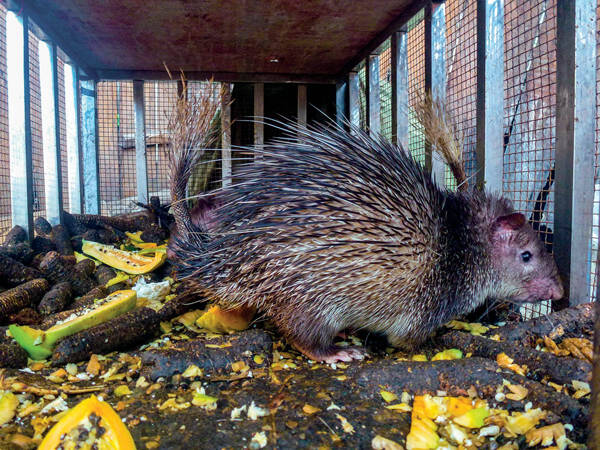Atherurus macrourus
IUCN
LCBasic Information
Scientific classification
- name:Atherurus macrourus
- Scientific Name:Atherurus macrourus,Brush-tailed porcupine, Asian brush-tailed porcupine, Asian brush-tailed porcupine
- Outline:Rodents
- Family:Rodentia Porcupineidae Broomtail
Vital signs
- length:350-520mm
- Weight:2kg
- lifetime:
Feature
Good at swimming and climbing trees.
Distribution and Habitat
In China, it is mainly distributed in the southwest, including southern Sichuan, Chongqing, Yunnan, Guizhou, Guangxi and Hainan. Abroad, it is distributed in India, Myanmar, Thailand, Vietnam, Malaysia and Indonesia.
It lives in dense subtropical and tropical mountain forests, building or occupying caves, which can be connected and can accommodate 3 individuals. It is active at night, often interspersed with sugarcane forests, bamboo forests and palm trees, digging seeds on the forest floor.
Appearance
Among the porcupines, it is a small one and looks long and thin. It has thorns all over its body. The thorns on the back of the body are flat and grooved, and the thorns on the abdomen are soft. The front and back legs are short and thick. The ears are short and round. The tail is relatively long, 150-250mm. There is a cluster of white thorns at the end of the tail (like a broom), and there is a beaded ball behind the thorns.
Details
There are 4 genera and more than 20 species in the porcupine family worldwide. It is a special type of rodent. There are 4 species of the genus Brushtail Porcupine worldwide, and 1 species in China. They mainly live in forests, especially forests near water. According to records, brushtail porcupines are good at swimming and can climb trees.

Brushtail porcupines are nocturnal, generally terrestrial, and occasionally climb trees. They feed on roots, tubers and green plants. It is a herbivore that feeds on roots, bulbs, fruits and berries of a wide variety of plants. It prefers fruits, vegetables, banana seedlings and other crops. Porcupines play an important role in shaping the diversification and spread of local services. For example, the burrows dug by Indian porcupines can promote the germination of seeds of many plants. In agricultural areas, they eat crops such as peanuts, potatoes, and pumpkins. African porcupines can also eat plants that are poisonous to livestock. Some brushtail porcupines can climb trees and eat fruits from various trees.
Porcupines are very skilled in handling food with their front paws, "pinning" the food to the ground with force, and then chewing it and eating it. Usually, porcupines forage alone, although sometimes they eat together in groups of three or two. They occasionally eat bones, which they bring to their dens to grind their teeth or absorb the phosphates in.
Mating is usually initiated by the female, who approaches the male, lifts her tail and hips, and points her bristles toward the male. The male then climbs onto the female's back from behind to mate. Two litters are produced each year, with 1-2 cubs per litter. The gestation period is 100-110 days. The cubs are born in a nest separated by grass in the underground cave system. The breeding room is covered with soft grass or fallen leaves. The cubs are precocious, with good hair covering their bodies, and their eyes can open. Soon after, the bristles covering them can turn into hard thorns, and they leave the nest after 1 week.
Newborn porcupines weigh between 300-330 grams and can eat solid food after 9-14 days. Although they are still cared for by their mothers for 13-19 weeks, they start to forage for food by themselves 4-6 weeks after birth. Porcupines have a relatively small number of cubs per litter, 60% of which have one, 30% have two, and wild porcupines only have one litter every summer.
Listed in the 2008 Red List of Endangered Species of the World Conservation Union (IUCN) ver 3.1 - Low Concern (LC).









